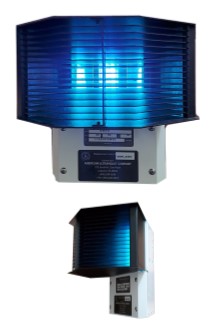
UV-C Corner-Mount Upper Air Units
When looking into UV-C light to protect you, your clients and your family from viruses, there are three current technologies to consider. These are hand-held devices, upper-air units and HVAC units.
DELANO, Tenn. (PRWEB)
March 24, 2020
UV-C light is one of 4 different wavelengths of ultraviolet light. UV-C has the shortest wavelength and is the most powerful at killing viruses and bacteria. The ozone layer does not allow UV-C light to reach the earth’s surface. Therefore, organisms have never been exposed to this form of UV light and they have no resistance to it. That is why they quickly die when exposed to artificial UV-C light sources. Direct UV-C light is also dangerous for humans. It can cause eye irritation and sunburn upon exposure. UV-C germicidal devices are generally designed to prevent skin or eye exposure but it is important to remember to avoid looking at the light or allowing exposure to bare skin. Also, do not touch the bulbs with bare skin as the oils from our fingers etch into the quartz and shorten the life of the bulb.
CURRENT UVC TECHNOLOGIES TO KILL VIRUSES & BACTERIA
When looking into UV-C light to protect you, your clients and your family from viruses, there are three current technologies to consider. These are hand-held devices, upper-air units and HVAC units.
(1) Hand-held UV-C units: Commonly used to manually sanitize items or surfaces by slowly moving the light over the object. Example are kitchen counters, bathroom handrails, toilet surfaces, sinks, cell phones, keyboards, chairs, door knobs, light switches, etc.
(2) Upper-Air UV-C units: Upper-Air UV-C devices have been used in the healthcare industry since the 1960s. They are unique because they can be used in occupied rooms. The Upper-Air units are mounted at a height of 7 or 8 feet on the wall. Louvers on the units direct the UV light upward. This creates a zone of UV-C light at the top portion of the room, above the occupants. Natural convection, air from HVAC vents and human movement cause the air in the room to circulate. As air enters the disinfection zone, it is exposed to the UV-C light rays, destroying viruses and bacteria in the air.
(3) UV-C lights for HVAC: These units are installed inside the HVAC unit, thereby turning the air handling system into a giant virus-killing air purifier. There are units that are designed specifically for evaporator coil disinfection and units designed to purify the airstream inside the ductwork.
DON’T JUST BUY A BLUE LIGHT
A word of caution. Anyone can make a blue light and call it “UV-C” or “Germicidal.” Here’s what to look for:
a) The most effective germicidal UV-C light has a wavelength of 254 nm. Make sure the seller or manufacturer specifies the wavelength of the light.
b) Many sellers only measure their light in bulb wattage. The lamp wattage stats show how much power the lamp uses. What is much more important is the lamp OUTPUT or intensity, which is measured in units of microwatts/cm2. So, keep in mind that UV-C light is about time and intensity, not just energy usage in watts. If a UV-C light manufacturer or seller does not provide the lamp output in microwatts/cm2, there is no way to prove it’s germicidal and no way to properly calculate the “kill rate” with specific viruses or bacteria.
c) Do not purchase a unit that produces ozone as this gas is harmful to humans.
d) Make sure you purchase a unit from a company that will be around to provide warranty service and replacement bulbs when needed.
SUMMARY
In conclusion, UV-C light has been proven to be an effective method of killing viruses and bacteria. There are UV-C technologies available for specific applications to effectively reduce the spread of viruses by touch or through the air. Caution is needed when choosing a UV-C device that is safe and effective. For more information on UV-C light and viruses, visit us at http://www.KilltheCoronavirus.com.
Share article on social media or email:

